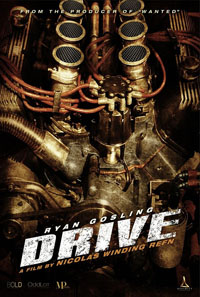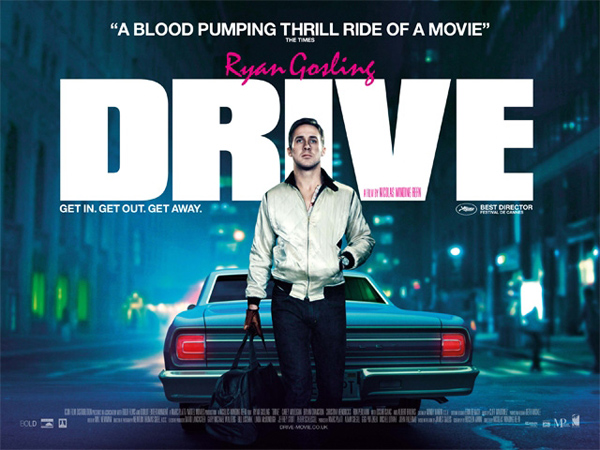 Nick Nunziata (Twitter): Nicolas Winding Refn’s Drive feels like some sort of postmodern mash-up of To Live and Die in LA, Thief, and Miami Blues, which is a very good thing. Rich in atmosphere. Tonally lean and mean but somehow literary. Raw and vicious in a way unlike other recent violent films, it feels like a film out of time in how it marries elements old and new. Somehow it all works as Refn’s cocktail of 80’s synth pop and hypnotic overhead shots of Los Angeles lull the viewer into a rich and dangerous world where life is cheap and an iconic Hollywood stunt driver is the baddest cat on the block.
Nick Nunziata (Twitter): Nicolas Winding Refn’s Drive feels like some sort of postmodern mash-up of To Live and Die in LA, Thief, and Miami Blues, which is a very good thing. Rich in atmosphere. Tonally lean and mean but somehow literary. Raw and vicious in a way unlike other recent violent films, it feels like a film out of time in how it marries elements old and new. Somehow it all works as Refn’s cocktail of 80’s synth pop and hypnotic overhead shots of Los Angeles lull the viewer into a rich and dangerous world where life is cheap and an iconic Hollywood stunt driver is the baddest cat on the block.
Renn Brown (Twitter): It’s that 80s-style backdrop of broiling sunlight, fast cars, and nighttime streets crackling with sex and crime that allow a stoic hero that rarely speaks to exude danger from his first frame. As much as the texture of the film is seeped in overcooked synth and the big underworld figures of those classic crime films though, the Driver himself is straight out of a nihilistic 70s revenge story. Never uttering an unnecessary word, we can only guess at the horrors he’s seen and the scars he carries. We’ll never know though, as the script is so confidently focused on telling the story at hand that not a single periphery detail is considered. The extent of the character exposition dumped about the Driver comes from his boss and partner, merely equating to, “he showed up one day, I put him to work.” Meanwhile, Refn’s Euro-art sensibilities dance around this pulp story –that could have come out of any old dime-crime book or Patterson novel– in such a way that romanticizes it, toughens it, and ultimately makes it a classic.
Nick: Well it is based on a pulpy novella so that helps tie it to the literary world fine enough and it could easily have trickled from the typewriter of Richard Stark or early Elmore Leonard, but this is a weird little movie almost living in the world between homage and adaptation. It’s at least a tipping of the cap to the films of yesteryear. In today’s market this would star Jason Statham and be filled with drawn-out fisticuffs and Refn obviously enjoys taking a very familiar story of today and marrying it with a very familiar story of yesterday and discarding the worst facets of each. There’s no cute dialogue, no fight scenes completely built by blocking and editing, and the violence is immediate and permanent. It’s refreshing to see, and many will mistake Refn’s film for some sort of genre pioneer when it actually is a delightfully lucid throwback.
Renn: It’s definitely riffing on a classic set-up, to the point that the simplicity of its story would make most any other film feel slight. It’s as simple as “a stunt driver who does getaway driving on the side falls in love with a girl, gets wrapped up in a mob kerfuffle that puts them both in danger. He handles it.” That’s a perfectly fine story to spark a solid, ultimately forgettable genre entry, but what Refn does here is take apart all these very classic pieces of the story and examine them through his own special lens. The chase scenes are gripping and well-shot, with an inventive but stripped-down choreography to them, while the scenes in which the Driver falls in love are classically told, but with a patient sense of artistry. It’s all familiar, but every inch of it is captured with a sophisticated eye for light and texture and beauty that you wouldn’t typically see in a film like this. That’s all on top of a great cast that puts in the work to give Refn a bedrock on which to build his art-action film. Albert Brooks and Ron Perlman would be a new favorite mob-brother duo, Bryan Cranston a memorable tragic middle man, Mulligan a sweet woman worth helping in any crime film in which they appeared. Here though, that rich cast empowers the film to be unusually operatic at points, which in turn lends more gravity to the performances. It’s a self-perpetuating cycle of entertaining greatness.
Nick: Or at least very goodness. I’m not convinced the film is great, but it is a lean mean machine. Ryan Gosling is a fantastic actor, one whose choices and unfair pigeonholing because of The Notebook has kept many from seeing him at full capacity. Here he’s all about calm and quiet and it makes his explosiveness that much more effective. Were he not surrounded by larger than life performances from the likes of Albert Brooks, Ron Perlman, and Bryan Cranston the minimalist approach would have been construed as bad work, but his steadying influence is not like some of Clint Eastwood’s more iconic roles. With the weird old school synth-pop and Refn’s absolutely unique sense of pacing it’s a pretty damn tasty concoction. Albert Brooks is going to make some new fans here as a psychotic mob boss and part of that can be attributed to the gleeful manner he embraces the role but what’s surprising is how well he pulls off the menace. I still don’t get Carey Mulligan but she doesn’t do anything to hamper the film here. Christina Hendricks is involved as well but does little to register. With her curves downplayed she doesn’t have a strong enough presence. Oscar Issac brings a good bit of depth and humanity to what would normally be a very one note role.
Renn: If we’re listing down performances, then yes on most fronts. Brooks is a revelation as a villain, and it’s wonderful to hear that unmistakable voice easily twist into something menacing. He also bounces well off Ron Perlman, conveying brotherly love and frustration in a way that really says, “well I don’t like you, but fuck everyone else because you’re my brother.” The cold matter-of-factness ever so slightly tinged with regret reads strongly as he starts tearing down people and things he is excited about just to undo his brother’s foolishness. It’s the reason there’s already a lot of (overly) enthusiastic awards talk for his performance. Perlman is great and sleazy in all the right places, but he’s more of a stock role. The same is true of Mulligan, but she also has the chops to be more than a mere object while still fulfilling the angelic archetype the movie needs. I have to disagree about Hendricks though– her curves aren’t downplayed in the slightest, they’ve simply not been shaped and engineered with flattering costume and lighting in ways that are obviously attractive, yet still make guys feels good about themselves for liking a woman “with curves.” She looks how a woman her size looks, which isn’t a problem, but she’s playing a trashy character.
Nick: I suppose. I love Hendricks on Mad Men, but the balance of thankless role and image busting appearance does nothing to justify her presence here. I know it sounds base of me, but this is an actress who has done really amazing work towards building a mystique and a rather strong screen presence. This is the kind of movie where a femme fatale would be perfectly at home and that’s where you pencil in a Christina Hendricks. I see her in the credits I expect more. And that’s not my dick talking. I’m not one of her devotees by any stretch. The star of the movie is Refn. These days you absolutely have to introduce wildcards to the mainstream genres to inject some energy and his presence here gives the movie an identity in a massively crowded market. In the same way that Paul Verhoeven brought fire to the 80’s, Refn and others like him have the ability to vitalize action movies now.
Renn: What I think takes the film beyond being simply solid or cool and into legitimate greatness is a combination of two things we’ve covered: the flawless but very restrained way in which it hits familiar notes in a familiar story, and the uncommon artistry present in the texture and the filmmaking of the movie itself. By nature that puts a lot of the credit at Refn’s feet, but he earns it by bravely shoving his subtly experimental techniques into an action movie, without ever allowing them to compromise the straightforwardness of the story, or the entertainment value. It’s a perfect merging of craft, aesthetic and exhilaration. This is the promise of a filmmaker like Refn, who has no problem engineering a heavenly lit moment in an elevator that turns a long-desired kiss into a moment of operatic romance that seamlessly pivots into a event of brutal violence. And this is no empty flight of fancy, as the scene forces these two realities of the story to face each other with no clear reconciliation in sight. The film is filled with these kinds of moments– pedestals elevating an otherwise suitably polished action flick.
Nick: It’s abnormal, which may put off some viewers. Its pacing is measured and it’s nowhere near as action-packed as folks might expect. It’s just damn good. Damn confident. And as I said before a really nice film that nestles right alongside some of my favorite ballsy thrillers. I truly believe that were this released in the mid 80’s amidst the great Mann and Friedkin flicks, it’d be another notorious member of an elite crew. As it stands, it reminds us that there’s plenty of space in this playground for great filmmakers [and Refn is great] to absolutely kill it.
Renn: It’s the rare genre effort that fits so well among the films that inspired it while simultaneously feeling like something completely unique, but Drive accomplishes that feat. This is a balls-to-bone, night-lit, LA action flick directly descending from all those films Nick mentioned at the top, and it’s also a modern, elegant art film. There’s something magical happening anytime the Driver is in a car, be it heart-pounding racing or slow cruising with the Driver in deep focus, all passing sound registering at some ethereal frequency. It’s a wonderful duality that will satisfy film fans of a hunger they might not have even realized they had. To put it pointedly, Drive is a classic from its first scene. It’s the best-looking, best-sounding, most dangerous film of the year.
Rating: 




Out of a Possible 5 Stars
